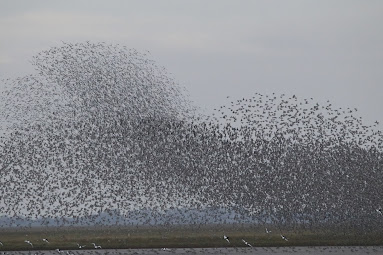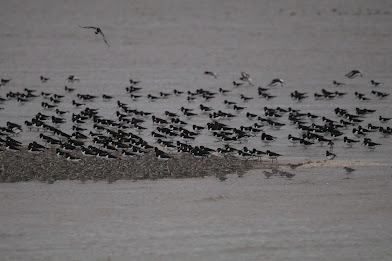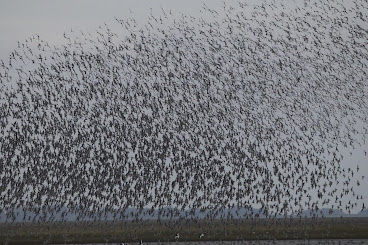For such a nature deprived country, certain places in these isles can still pack in the wildlife spectaculars. Our estuaries are the envy of the rest of Europe, attracting millions of birds to our shores. However it can be difficult to really appreciate the sheer number of birds that inhabit these areas. On our largest estuary, the Wash, which was the focal point of today's visit, and specifically at the RSPB reserve of Snettisham, there was a WADER SPECTACULAR like no other.
On certain high tides the exposed mud, and the hundreds and thousands of birds that feed on it, gets covered by the water. As this happens all the many birds present get pushed further and further towards land, forming huge swirling flocks as they do so. The number of birds can be quite staggering when seen in real life. And as the final areas of mud are covered up the birds fly over the sea wall to roost on the gravel pits inland.
To witness the spectacular, tide heights have to be right. If they are too low, there is still enough mud exposed for the birds to roost on. This has happened to me many a time, turning up at the reserve only for the tides no to be right and failing to witness the spectacular, the waders remaining distant. The tides have to be high enough and today the tide was just right, which meant a visit to Snettisham for seven in the morning, with the high tide somewhere before nine.
Walking from the car park, I hit the sea wall, and the tide was still quite some way off. I was wondering if today was going to be another bust, like so many before. I headed down to the furthest gravel pit, near the far hides. People had already packed the area with as many as 150 people present. The tide came in deceptively slowly, but even with half an hour to go, there was still a lot of mud left out there.
With the incoming tides came the swirling murmarations of WADERS, distant at first on the water's edge, but coming in closer with the tide, as the water's edge came closer. In the distance the wildfowler's guns went off as the birds gradually came in. With such an awesome spectacle it felt pedantic to separate the individual species, but KNOT were there in the largest numbers, unimpressive singly, a grey bird, but amazing in a flock thousands strong.
And as the tide completely covered the mudflats the thousands of waders, now so close, murmarated high above our heads, and the birds with nowhere else to go flew onto the gravel pits behind.
The new hide, built since I was last year, wasn't your typical hide, it had seats created like a terrace, with large glass windows open to the gravel pits, which made almost like watching a play, allowing the watcher to just admire the spectacle of the many birds there. The gravel pit banks were coloured grey by huge numbers of knot, the birds packed in tightly as one entity
When looking at the news later on that day, it was reported that the roost today held record numbers of KNOT, that 140,000 of that species was present. Yes that's one hundred and forty thousand birds present. What a time to be a birdwatcher!
After a couple of hours, emotionally spent I left the reserve, knowing full well that I have achieved another tick from the bucket list, that I had witnessed something unique in the birdwatcher's world. I often say this, but really do consider visiting this spectacular, everyone should witness this, it truly is a spectacle. Witnessing this may help people appreciate the true awesome of nature, as something that can't be tamed by humanity as a force of good in the world.








No comments:
Post a Comment